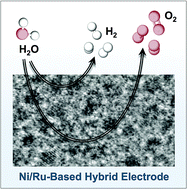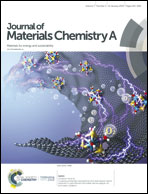Arising synergetic and antagonistic effects in the design of Ni- and Ru-based water splitting electrocatalysts†
Abstract
In the development of water splitting technologies, the design of hybrid architectures incorporating multiple phases which provide active centers with precise functionalities is a promising strategy. Herein, we report the design of Ni- and Ru-based electrocatalysts within a wide Ni/Ru ratio range, prepared through a one-step heat treatment of ultra-thin ruthenate nanosheets and NiCl2·6H2O and NaH2PO2·H2O precursors. At 250 °C under an argon flow, a pristine Ru electrode was shown to undergo preferential ruthenate-to-metallic Ru phase transformation, revealing preferable hydrogen evolution reaction (HER) fingerprints. At low Ni/Ru ratios, the interaction between the Ni2+ ions and the negatively charged ruthenate favored the in situ growth of highly dispersed surface Ni-based moieties below 5 nm in diameter. XPS measurements confirmed, however, that these narrow moieties were swiftly oxidized to NiO, whereas larger Ni-based agglomerates at higher Ni/Ru ratios were less prone to oxidation. This size-dependent propensity of Ni2P moieties toward oxidation, reported here for the first time, agrees with the surface oxidation of Ni2P nanoparticles (50–100 nm) to a limited extent. At Ni/Ru = 0.36, the incorporated NiO favored a synergistically superior oxygen evolution reaction (OER) performance and an optimal 1.7-fold activity enhancement at limiting current densities. An antagonistic effect in the HER performance of these hybrid materials was, nonetheless, simultaneously observed and ascribed to the blockage of the active Ru surface. While the performance of these nano-architectures remains a modest addition to the current state-of-the-art of water splitting platforms in alkaline electrolyte media, our results primarily reveal representative bottlenecks in the integration of multiple phases during synthesis steps and the effects of arising between integrated components on the catalytic behavior of resulting hybrids.



 Please wait while we load your content...
Please wait while we load your content...